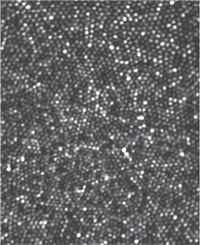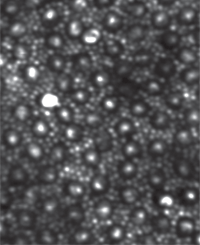For the first time ever, scientists captured clear and direct images of rod photoreceptors in the living human eye.
Using adaptive optics, researchers from the University of Rochester were able to view the tiny light-sensing cells with unprecedented detail.
They described the landmark discovery in two papers published in Biomedical Optics Express.1,2
Photo: Biomedical
Optics Express/University of Rochester.
This breakthrough will help clinicians diagnose degenerative eye disorders sooner, enabling them to intervene more quickly and treat patients more effectively, the researchers predict.


Photos of cone cells (shown here) have become standard in high-resolution retinal imaging research.
Adaptive optics has now made it possible to view the rods—the many smaller dots in this photo. (The larger dots are cones.)
Using a noninvasive, adaptive optics imaging system, the team was able to push the device’s resolution to nearly 2µm—the approximate diameter of a single rod in the human eye.
Earlier systems could achieve effective imaging of cones and have become standard in high-resolution retinal imaging research, but they were unable to clearly capture the smaller rods, which outnumber cones 20 to 1 in the retina.
The team’s next step will be to create a clinical model of the system that could be widely used. Then doctors would need training on how to interpret adaptive optic images to guide their clinical decisions on diagnosis and treatment.
Visualizing rods in the eye clearly and precisely could allow eye doctors to describe the physical presentation of specific rod disorders, intervene at the first sign of disease, and more accurately measure how individual cells are responding to treatment, the researchers conclude.
1. Dubra A, Sulai Y, Norris JL, et al. Non-invasive imaging of the human rod photoreceptor mosaic using a confocal adaptive optics scanning ophthalmoscope. Biomed Opt Express. 2011 Jul 1;2(7):1864-76.
2. Dubra A, Sulai Y. Reflective afocal broadband adaptive optics scanning ophthalmoscope. Biomed Opt Express. 2011 Jun 1;2(6):1757-68.

